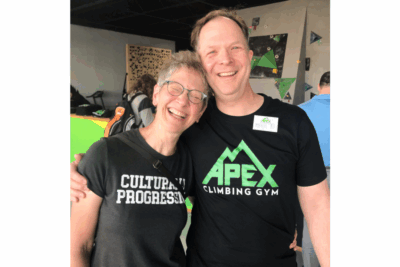Steve Shantz, the systems supervisor and emergency medical services coordinator for Goshen College, wanted to see the stars on his own terms. So, Shantz built a telescope from scratch.
“As a kid, I always sort of wanted a telescope and money was tight. It wasn’t really important so I never had one.” Shantz said.30 years ago, a man Shantz worked with told him that he made his own telescope mirror. “He grounded it and polished it into a spherical mirror, and the last step is transforming the spherical surface to a paraboloid,” he said.
Hearing this, he thought that he could make his own. Shantz sent $110 to Palomar Optical and sent back an eight-inch Pyrex disc and an eight-inch flint glass. The Pyrex becomes the mirror and the flint glass becomes the tool. With it, he received a whole collection of grinding abrasives.
Shantz checked out the book “How to Make a Telescope” from the Goshen Public Library. “It’s a classic,” said Shantz. He kept renewing the book because “the book had all the instructions of how to grind.” The librarian who checked out the book at the circulation desk said that he could keep the book until Shantz was done.
Shantz was always busy during the summer, so the telescope was a late fall and winter project. Two years later, Shantz finished grinding and polishing the mirror and sent the piece to be aluminum coated. He then returned the book.
“It was a big rush to get it finished because there was a comet named Shoemaker Levy 9 that was going to smack into Jupiter,” said Shantz. In 1994, the comet broke up into a bunch of pieces that formed a long line. Many pock marks were left on Jupiter’s surface in the aftermath. “I was feverishly working to finish my telescope and I did get to see several of the pock marks,” said Shantz.
Shantz stated that he hasn’t used his telescope since going to “star parties,” which were from an astronomy class that is taught here at GC. Shantz followed alongside John Ross Buschert, a former professor of physics. Buschert taught Descriptive Astronomy for about two decades.
Buschert, whose professional research focused on physics and music, said that before he taught his first astronomy class, he took a summer workshop.“It was a one week long workshop on astronomy, and it was taught by a real astronomer,” said Buschert.
Buschert mentioned that he was committed to introducing students to actual stargazing. “When I first started teaching astronomy, the first thing I wanted to do is make sure people actually got outside and saw some stars,” Buschert said.
Every semester Shantz would take the class to Merry Lea Environmental Learning Center. He found it very difficult because, “there’s a lake effect cloud cover that we get here, so it makes [stargazing] a challenge.”
They would all set up the telescopes and gaze at the stars. “I would go overnight. We would actually spend the night there and just sleep in the barn,” said Buschert. He talked about bringing other people along with him besides his students including Shantz and Ron Kennel, a retired pastor.
“What I always want when I go to Merry Lea is for everybody to see all the things they want to see. Sometimes it happens and sometimes it just doesn’t,” says Buschert.
Manu Bhattarai, new physics professor, teaches the Descriptive Astronomy course after having taken it over in 2024. Bhattarai grew up in Nepal where he would always stare up at the night sky. “I liked it, the sky was clear and the stars were visible, but no one was there to teach us about it, so I never got into it seriously,” Bhattarai said.
Before coming to GC, he wanted to get more into stargazing so he bought a telescope. However, due to some personal reasons, he never got around to it.
During his first year teaching the course, Bhattarai adopted most of the material that Buschert had left for him. “I made some changes to the assignments and projects to fit my teaching style, but overall, I kept most of the material the same,” said Bhattarai.
One thing he has adopted in particular was the stargazing trip to Merry Lea. During his first year, he contacted Buschert to help. However, only two students showed up. “It was around 5 a.m. and it was short notice, so I understand why,” said Bhattarai. He mentioned that it was too difficult to schedule in advance because predicting when the sky would be clear was difficult.
Bhattarai was not able to take his class stargazing last May term, but he plans on making the class a regular basis in upcoming years.
“Though I’ve always looked at stars and astronomy from a theoretical perspective using simulations and physics equations, I realized there was a lot more to it, and I am still learning while simultaneously teaching the course,” Bhattarai said.
Bhattarai thanks Buschert by saying, “I couldn’t imagine teaching the course without using his materials. They are very well put together and sophisticated.”



